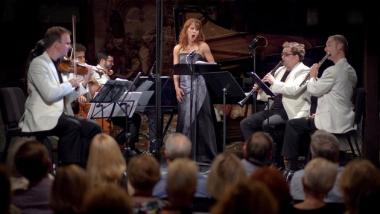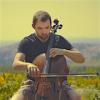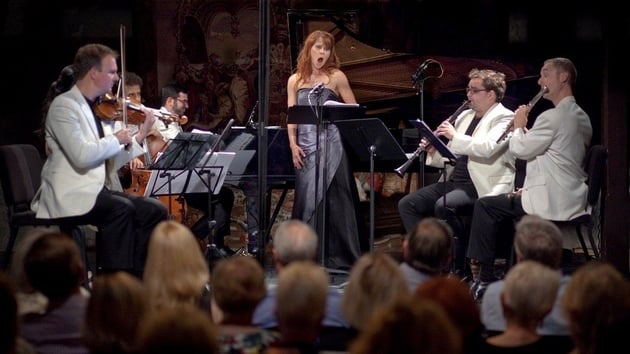
A good wine needs aging. The Music in the Vineyards series (aka the Napa Valley Chamber Music Festival), which just finished its 24th season, continues to successfully showcase vintage music for small ensembles (much of which ages well) and brand-new creations. Both were served up among the fragrant wooden casks of the Inglenook Winery, on a bountiful, sunkissed Napa Valley estate this past Sunday.
Recently returned from a tour in South Africa with the Minnesota Orchestra, violist and Festival Co-Artistic Director Michael Adams introduced the program’s first offering, Luigi Boccherini’s Flute Quintet in E-flat Major, to the full, well-coiffed house. The piece was brief and melodically simple, what might be termed “Baroque Light.” Though the ensemble at times sounded off-pitch, the performance evoked the languid spirit of the vineyards, the violins made to chirrup and warble.
Composer Maria Schneider’s Carlos Drummond de Andrade Stories began as a commission in Schneider’s home state, from the St. Paul Chamber Orchestra. It had been her first time writing for and conducting a symphony orchestra, rather than working with the jazz big bands for which she’d trained (with legendary arranger Gil Evans, among others), performed, and recorded.
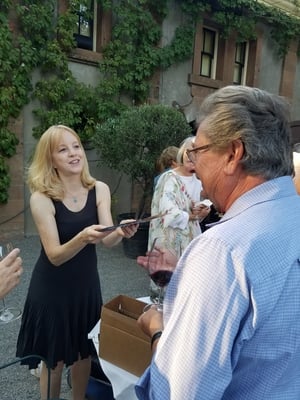
What’s structured as a sort of song cycle of verse by preeminent 20th-century Brazilian poet Drummond was premiered in 2008, led by Schneider and vocalized by Dawn Upshaw, who was invited to bring it to Napa but couldn’t. Festival Co-Artistic Director (and violinist) Daria Adams then suggested that Schneider reduce the piece for a smaller ensemble and stage the premiere of the new version this year, with Chicago-based soprano Diana Newman. When Newman turned ill several weeks ago, Bay Area coloratura Nikki Einfeld stepped in as a courageous, last-minute replacement.
Recently lauded as a “Jazz Master” by the National Endowment for the Arts, Schneider prefaced her piece with a discussion of its musical inspirations, ranging from Brazilian choro to flamenco. She lauded the “human” feel of the five poems of Drummond, translated from Portuguese by Mark Strand.
The piece’s “Prologue” clearly and delightfully did homage to Villa-Lobos in its harmonic movement, as well as in the vocalese sounded sweetly but strongly by Einfeld. The clarinet and flute (Greg Milliren,) reinforced the Brazilian lyrical affect. “The Dead in Frock Coats” was delivered with the adoring phrasing often present in Schneider’s music. Einfeld’s sustained vibrato was thrillingly tangible within the small venue, ramified by the throbs of the cello of Nicholas Canellakis, who has performed in duo with this ensemble’s pianist Michael Brown. Violinist Axel Strauss added sparkling, high-frequency overtones.
“Souvenir of the Ancient World,” a radiant portrait of a garden, showcased Schneider’s almost cinematic evocation of landscapes, apparent on her Grammy-winning 2017 album, The Thompson Fields. “Don’t Kill Yourself” set sweet Iberian melodies in engaging and sometimes dancy polyrhythms, encouraging Einfeld to showcase her animated theatrical talents. The final song, “Quadrille,” proved charming but rather triste, in a Brecht/Weill manner.
The set overall was as tangibly rewarding for the virtuoso ensemble as for the audience, which rose to its feet and demanded an encore. This was “Walking By Flashlight,” Schneider’s setting of the words of U.S. Poet Laureate Ted Kooser, recorded with Dawn Upshaw on The Thompson Fields. The ensemble and Schneider’s tender arrangement magically evoked the menagerie of midwestern animals observing the poet/singer’s nocturnal perambulation.
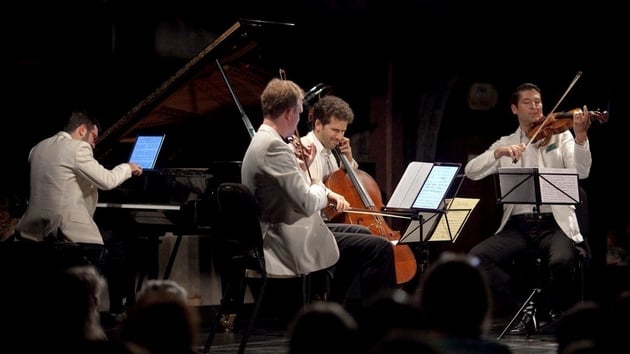
Brahms’s Piano Quartet No. 3, written under the influence of the composer’s unrequited love for Clara Schumann and long kept from the public, filled out the second half of the program.
A dramatic contrast in mood to the Schneider offering, the first movement Allegro affected a “tragic musical sigh” in C minor, as described by Adams, but was rather turgid, with lots of unisons and not much in the way of individual instrumental expression. The Scherzo took the players on a rough canter, requiring exacting interaction, for which they were quite able. The E major Andante was arguably the most listener-friendly portion of the quartet, cellist Nicholas Canellakis lovingly phrasing the melody, then passing it to violinist Axel Strauss. The ensemble handsomely realized the familiar, rich tones. The final Allegro comodo movement returned the composer’s somewhat somber mood but sent listeners home with a couple of surprising forte C major chords, effective in auguring the delights of the festival’s 25th season next summer.

